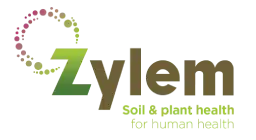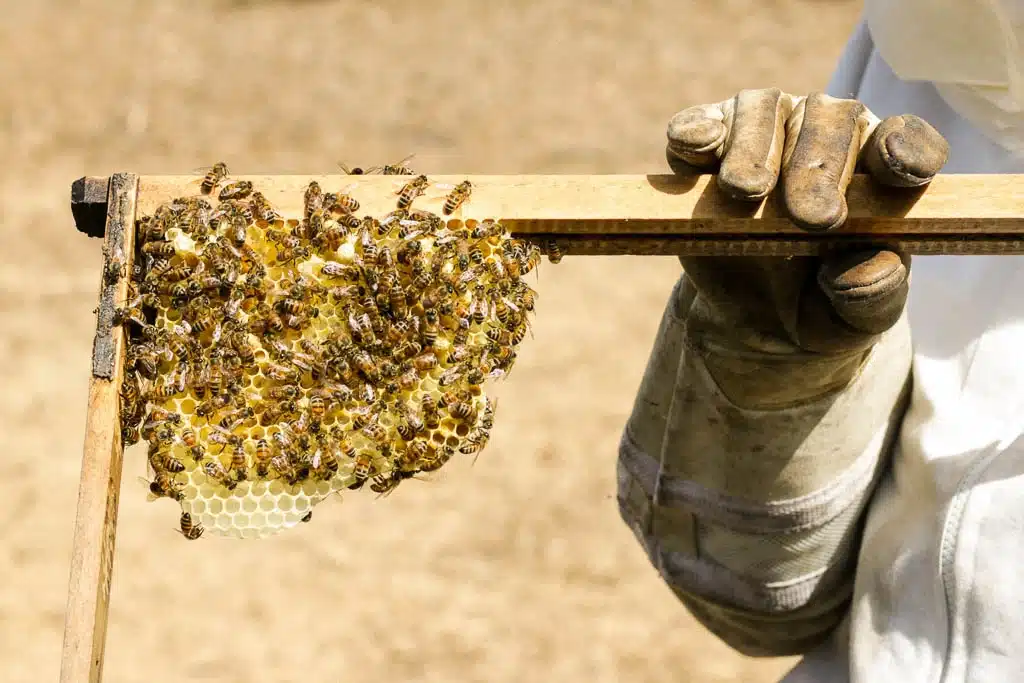In this article:
Why should we care about bee populations?
Reducing the risk to pollinators and South African honey
What about ‘fake honey’ in South Africa?
The trouble with honey testing
The problem with honey adulteration
How to avoid buying adulterated honey
Zylem supports South African honey farming
The world’s declining pollinator populations are placing our food security under threat. South Africa and the world wants more honey. But amid the rising demand for honey, we are seeing a rapid decline in bee populations worldwide. The dwindling bee population goes beyond being concerned about having something sweet to drizzle on your yoghurt; it is a great threat to various plant species, food security and millions of livelihoods. Another issue is the not-so-sweet world of ‘fake honey’, which is causing many South African honey companies to struggle to keep their businesses going since they cannot compete with the low prices of adulterated honey.
“The growing threat to pollinators, which play an important role in food security, provides another compelling example of how connected people are to our environment, and how deeply entwined our fate is with that of the natural world. As we work towards food security, it is important to approach the challenge with a consideration of the environmental impacts that drive the issue. Sustainable development, including improving food security for the world’s population, necessitates an approach that embraces the environment.”
- Achim Steiner, Executive Director, United Nations Environment Programme (UNEP)
Why are bees under threat?
The majority of the world’s beekeepers and producers of South African honey are facing daunting challenges, largely as a result of unsustainable agricultural practices.
There are several factors affecting bee populations, including:
- Changes in land use
- Widespread chemical and pesticide use
- Air, water and soil pollution
- Alien invasive species
- Pests and diseases
- Climate change
- Intensive agriculture
- Habitat destruction
- Even subsistence farming practices like slash-and-burn techniques and traditional honey-gathering practices have a negative impact on bee habitats
Why should we care about bee populations?
According to the United Nations’ Food and Agriculture Organisation, pollinators (such as bees) are economically, socially and culturally important, contributing to world food production and nutritional security. Crop yields are dependent on both wild and managed species. Even when managed bees are present in large numbers, a high diversity of wild pollinators contributes to increased stability in pollination.
More than three-quarters of the world’s food crops rely (at least in part) on pollination by insects and other animals. Pollinated crops include those that provide vegetables, fruit, seeds, nuts and oils. These crops not only contribute to human nutrition, but are also an important source of income, particularly in developing countries. For example, the production of coffee and cocoa cannot take place without pollination. In South Africa, it is estimated that honey bees pollinate over 50 crops.
| Pollination Fast Facts 90% of wild flowering plants depend at least to some extent on animal pollination 300% Increase in agricultural production dependent on animal pollination during the past 50 years 70% of the 100 crop species that provide 90% of the world’s food are pollinated by bees |
Reducing the risk to pollinators and South African honey
Sustainable agricultural practices help to diversify the agricultural landscape and use ecological processes as part of food production. Examples include:
- Maintaining or creating greater diversity of pollinator habitats
- Supporting regenerative practices such as crop rotation
- Reducing pesticide use
- Improving soil health for healthier plants and a healthier ecosystem
Pollinators form part of a healthy ecosystem. With sustainable and regenerative practices, it is possible for pollinators and farmers to work in natural harmony. And put quite frankly, we don’t actually have a choice.
What about ‘fake honey’ in South Africa?
The South African honey industry is finding itself in a ‘sticky’ situation. Struggling to meet growing consumer demand for honey, South Africa relies heavily on Chinese imports for the supply of this natural sweetener. Most of the honey on the South African market is imported, almost all of it from China. South Africa’s honey consumption is 5000 tons per year, but honey farming in South Africa only produces 2000 tons, resulting in a supply deficit.
Wandile Sihlobo, head of agribusiness research at the AgBiz, says that imports of Chinese ‘honey’ into South Africa spiked from 20 tonnes in 2001 to about 3 600 tons in 2017. In 2017, South African bee hives only produced around 1 500 tons of honey per annum, compared to around 3 000 tons 25 years ago.
What is adulterated honey?
More than 70% of honey sold by retailers around the world is not ‘real honey’ at all; it’s honey that has been adulterated. Adulterated honey is actually a mix of sugar, water, and possibly some honey, if the consumer is lucky. Other adulterating components include corn, rice and sugar beet syrup. These additives are mixed with natural honey to boost volumes prior to bottling and selling. Adulterated honey is then sold as the real deal to consumers, who are largely uninformed about these false products.
Another trick used by some companies is to use the words ‘Packed in South Africa’ on their honey bottles, fooling consumers into believing they’re buying local honey, when in fact it has actually been imported from China, where honey adulteration is rife. Terms such as ‘irradiated’ (which disguises adulteration and origin) and ‘blended’ also appear on most commercially sold honey.
But it’s not only Chinese imports that are adulterated; some local honey producers are also guilty of the practice, as exposed in 2018 in a report on the investigative TV programme Carte Blanche. It was revealed that adulterated honey is making its way to the shelves of trusted retail chains, in-house honey brands, South African honey companies, and private label bottles.
What is irradiated honey?
Irradiated honey is honey that has been exposed to radiant energy to kill insects, bacteria, and other food-borne pathogens. By law, all imported honey needs to be irradiated to control diseases. While the process kills potentially harmful organisms, it may also destroy beneficial enzymes and other microorganisms.
The trouble with honey testing
Testing for added sugar in honey is neither simple nor cheap. This is because, although honey is nutritionally superior to sugar, it’s chemically similar to high fructose corn syrup and white sugar. Effective tests are therefore incredibly expensive. There are currently no laboratories recognised under the South African national accreditation system to work out the adulteration of honey, so samples need to be tested overseas.
The problem with honey adulteration
Essentially, honey adulteration is fraud.
- Threatens the health of diabetics
- Undermines the South African beekeeping industry’s viability
- Threatens South Africa’s agriculture and food security in general‚ given the key role bees perform in pollination
Around the world, the demand for honey is booming. Yet there are fewer bee populations, and many beekeepers are struggling to keep their businesses going since they cannot compete with the low prices of adulterated honey.
Along with supplying honey, South Africa’s beekeepers and honey companies also play a critical role in ensuring that the country’s commercial crops are able to compete in global markets. By providing pollination services, bees are a key component of the agricultural industry. The demise of the South African beekeeping industry is detrimental to consumers, commercial farmers, agricultural jobs, and the South African economy as a whole.
In 2009 and 2015, South Africa experienced devastating outbreaks of American Foul Brood (AFB) disease. This disease wiped out thousands of bee colonies across the Western Cape, threatening the country’s food security. People believe that the disease was probably introduced into South Africa by imported honey.
How to spot fake honey
Here are three simple fake honey tests you can do at home:
- Mix equal parts honey and methylated spirits. Real honey will sink to the bottom, while fake honey will mix with the spirits.
- Drop a teaspoon of honey into a glass of water. Raw honey will drop to the bottom of the glass intact, whereas fake honey will immediately start to dissolve.
- Place a drop of room temperature honey on your finger. If the honey spreads, then it is fake honey.
Remember: Honey’s quality has nothing to do with its colour since the colour depends on the source of the nectar.
How to avoid buying adulterated honey
- Buy honey that is produced (not packed) in South Africa – particularly beware if the origin is China
- Choose honey companies that produce non-irradiated honey
- Honey price in South Africa: expect to pay at least R80 for a 500g bottle of pure South African honey
- Taste and smell. If it tastes like syrup‚ it probably contains syrup—a lot of it!
- Look for a guaranteed traceability sticker on the lids or the bottles of the honey
- Find a reputable South African honey brand that you can trust and stick to it
LOCAL REPUTABLE HONEY BRANDS INCLUDE:
Zylem supports South African honey farming
Bees are vital to our agricultural systems. Sustainable agricultural practices can help ensure that bee populations can continue to do the important work of maintaining our food systems.
Get in touch with the Zylem team to find out more about our sustainable soil health solutions. Contact us on 033 347 2893 or send us an enquiry.

About the Author: Alex Platt
Alex is Business Development Manager at Zylem. He’s inspired by the potential of regenerative farming and takes a special interest in the technology and products that are moving agriculture in a more sustainable direction.

